
MAKE contributing editor Charles Platt proposed a “Hypothetical Tremolo Wheel” in his article about online DIY guitar stomp-box communities (MAKE Volume 15, page 82, “Stomp Box Basics: Tremolo and Fuzz”).
Well, it’s hypothetical no more. I took Charles’ cue and built this Optical Tremolo Box, which reads a patterned disk with a light sensor to create a warbling volume effect (tremolo) that you can custom-program with any pattern you like.
How does tremolo work? So there’s your electric guitar, and there’s the amplifier it’s plugged into, and there’s the cable that runs between them. Open up that cable and you’ll find 2 wires — one “ground” and one held at a positive voltage relative to “ground.” The changing electrical potential between these 2 wires, over time, is what carries the sound signal.
What happens if you short-circuit those wires, bridging them with a third wire? The sound goes away. The charge can find its way home now, via the short, without ever bothering to go all the way through your amplifier. And so it does.
What if you bridge the 2 wires with a resistor instead? With a strong resistor, nothing happens — it’s still easier for the charge to go through the amp. With a really weak resistor, the sound cuts out. With a resistor in the middle range, the sound will be quieted, but not completely muted, as the charge divides itself between short and signal pathways. Use a variable resistor, and you have a crude volume control: turn the resistance way up, the sound will be loud; turn it way down, the sound will vanish.
And here’s where Charles had a clever idea: use a resistor that responds to light. Wave your hand in front of the photoresistor, and the volume will respond to the shadow of your hand. Mount a spinning disk with alternating clear and opaque bands in front of it, and the volume will follow the pattern on the disk, repeating as it spins. That’s tremolo — a repeating variation in volume over time.
Intrigued? Want to try building one? I thought you might. Let’s get started.
- Download the enclosure template.
- The circuit diagram is also available for download as a printable PDF.
- Download the sweep disk art (PDF) and print it onto an 8.5″×11″ transparency.

MAKE Volume 33 features our special Software for Makers section covering apps for circuit board design, 3D design and printing, microcontrollers, and programming for kids. Also, meet our new Arduino-powered Rovera robot and get started with Raspberry Pi. As usual, you’ll also find fascinating makers inside, like the maniacs on our cover, the hackers behind the popular Power Racing Series events at Maker Faire.
Try your hand at 22 great DIY projects, like the Optical Tremolo guitar effects box, "Panjolele" cake-pan ukelele, Wii Nunchuk Mouse, CNC joinery tricks, treat-dispensing cat scratching post, laser-cut flexing wooden books, sake brewing, growing incredibly hot “ghost chili” peppers, and much more.
On newsstands now, by subscription, or available in the Maker Shed



